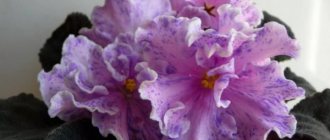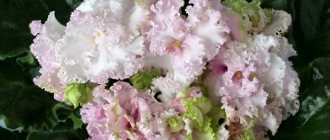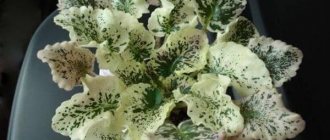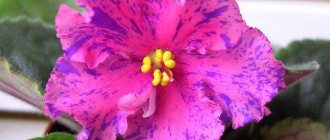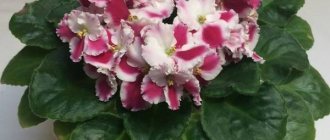Every breeder has the right :
- Recognize the bred seedling as a variety;
- And present it to society or not.
If for some reason a baby is rejected, it is usually simply destroyed . If the seedling is beautiful, but is not recognized as a variety, it usually stays and goes “to the people.” Such violets do not have an author's description, and sports in this case are not considered to be them.
You can see a photo and description of the variety below in the article.
Tatyana Pugacheva and her flowers
Kursk breeder Tatyana Pugacheva is known not only in Russia, but throughout the entire post-Soviet space. A wonderful woman, an excellent florist, made her hobby her life’s work. It is thanks to the efforts and labors of T. Pugacheva that the collections of many flower lovers are replenished with new specimens. Original author's varieties are sold both on the Internet, on a collector's website, and at various flower exhibitions.
Tatyana Pugacheva is a famous collector involved in the selection of new varieties . Her achievements have been recognized at various international exhibitions. She not only brings the fruits of her labor, but also actively communicates with flower lovers, helping them understand how to care for their pets.
Today you can read about Tatyana’s work with flowers not only on her website. The collector's work was noted by flower lovers. New, newly bred varieties are actively discussed on forums for indoor plant lovers.
Breeders were able to develop a large number of species of violets. Read our articles with descriptions of Saintpaulia varieties with the names of the people who grew them:
- Tatiana Dadoyan;
- Natalya Skornyakova;
- Korshunova Elena;
- Natalya Puminova;
- K. Morev;
- Svetlana Repkina;
- Elena Lebetskaya;
- Evgenia Arkhipova.
Features of flowering, growth and reproduction
During the first flowering, violet growers advise removing all peduncles, leaving only one , to ensure the varietal color. And after removing it, after a while the variety will open up with a lush head of flowers.
How long does it take to grow an adult plant?
From the moment the leaf cuttings are planted and the baby appears, it can take from two weeks to two months . The variety grows quickly, so after 8-10 months , you can grow an adult plant ready for flowering.
Reproduction methods, how are varietal characteristics transmitted?
The variety is propagated by stepsons and leaf cuttings from the mother's rosette.
When planting a cutting in the ground, from two to five children appear.
Varietal characteristics are transmitted well , but to be sure, it is better to let two grown specimens bloom.
What do flower stalks look like?
Peduncles are long but strong . At the first flowering, they may not be able to withstand the weight of double buds.
With abundant flowering, the buds may fall on the rosette , which makes its appearance slightly sloppy.
Is it possible to achieve cap flowering?
With proper care, timely regular feeding and watering, the PT-Jacqueline variety will constantly delight you with abundant cap flowering.
Bud lifespan
PT-Jacqueline blooms for more than a month. Flowers bloom slowly and gradually increase in size.
The most popular varieties
There are no unbeautiful flowers! Many flower lovers will agree with this statement. But, every breeder has varieties that are especially loved by plant fans. Among the varieties bred by Tatyana Pugacheva there are some that can be distinguished.
PT "Tsarskaya Osoba"
The variety is distinguished by a neat, dense rosette. The flowers are large, purple-burgundy in color with a white wavy border along the edges. The variety can be either simple or semi-double. Flowers look extremely elegant and will decorate any apartment .
PT "Larissa"
Violet is distinguished by very large two-color flowers. Senoplia is white in color, has a lilac core and a yellow eye. The bush blooms very profusely and has a neat rosette of dark green leaves.
PT “Purple Flicker”
The leaves are medium green and form a neat rosette. The bush blooms with a large cap . On medium-double flowers, you can see transitions from light lilac to dark lilac; you can also observe nude tones on some flowers.
PT "Infinity"
The variety was released in 2016 and immediately became a favorite at exhibitions. A neat rosette is formed by light green terry leaves. Flowers are distinguished by their originality. They can be found both simple and semi-double. The main color is white, along the edges you can see a light green border of varying thickness. In the middle of the flower there is a pink core. It can range from dark pink to light pink.
Violet SM-Mazurka (Seedling Morev)
Attractive violet Mazurka.
Like all varieties, Morev Mazurka violets belong to the genus of hybrid Saintpaulias , from the Gesneriev family.
Like all seedlings, Saintpaulia does not have a description from the author , but among collectors this violet has long been assigned a “folk” name.
Socket:
- Medium size;
- Neat;
- Forms well at home.
Sheets:
- Rounded;
- Sometimes slightly elongated;
- With a heart-shaped base.
The color of the leaves is usually light green, but under different growing conditions the shade may vary slightly .
The flowers are very large (6-7 cm), double like pompoms. The color is quite attractive, the petals are white with spots:
- Raspberry;
- Slightly reddish;
- Chaotic.
Since SM-Mazurka is not a variety, but a seedling, it cannot have sports, but among flower growers there are several options for children that do not repeat its characteristics.
Attention! Often there are completely dark flowers, less often white ones, and sometimes the baby can bloom with non-double flowers.
A few secrets of good flowering from breeders
- Place. In order for a flower to delight with a riot of colors, it must be placed in a warm place. Saintpaulia is extremely sensitive to temperature. Therefore, in order for a flower to bloom and please the eye, you need to choose a cozy, warm place for it.
- Lighting. Lighting also affects the abundance of flowering and the brightness of flowers. Violets bloom regardless of the time of year. Therefore, in winter, in order for the bushes to have as many flower stalks as possible, they need to be given more daylight. To do this, special lamps will come to the rescue; they can be bought at any flower shop.
- Watering mode. Water is life.
Violets, like many other plants, love water. Therefore, in order for them to bloom well and please their owners, be sure to water the flowers. It is necessary that the soil is slightly moist. But, you need to observe moderation. Otherwise, you can “flood” the plant and excess water will only harm it. When a violet blooms, it consumes more water and the soil dries out much faster. Therefore, it is extremely important to be especially attentive to watering during this period of the bush’s life. - Wet air. An air humidifier is one of the main friends of indoor plants. Violets are no exception. To prevent young buds from drying out, you need to purchase a humidifier and use it constantly. This becomes especially true in the winter months, when central heating radiators greatly dry out the air in the room.
- Feeding and fertilizers. Flowering takes a lot of the plant's strength. Therefore, after the flower has faded, it needs to be helped to restore its strength. Otherwise, it will not bloom soon, and there will hardly be many or bright flowers. Modern mineral fertilizers are ideal for feeding. Depending on the concentration of fertilizer, flowers can be fed either once a month or with each watering. The phosphorus contained in the mixtures will strengthen the horse system and the bush will delight its owners with abundant flowering.
Reviews
Allah. “I’m not very happy with SM-Mazurka yet. The first flowering is very sparse. The flowers are small, crimson. The lack of white and fullness on the flowers is disappointing, but I will wait for the second bloom.”
Lyudmila. “The variety is simply incomparable, not at all demanding, and grows beautifully on the windowsill. I haven’t tried propagation yet, but I hope everything will be fine. It is blooming for the third time, the first time it was not very attractive, but starting from the second, the variety won me over. The flowers are simply huge, like shaggy balls. And the color of the petals is simply incomparable, white and crimson go together very well, and their number looks great.”
This violet is of interest to many gardeners.
Anastasia. “I’ve wanted this violet for a long time, and I didn’t care at all that it was not a variety but just a seedling. I bought two sheets at once as a guarantee, both took root and produced two babies. I kept everything until the second flowering to check which of them would correspond to the description. I received two original Mazurkas, one white-flowering double and one raspberry semi-double. As a result, I kept three for myself, and gave one of those that matched the description to a friend. The rosettes never tire of making me happy, they bloom often, abundantly, and the flowers are simply beautiful.”
Varieties that deserve special attention: description and photo
Each breeder’s collections have their own “stars” . These are not only plants that have gained popular popularity. As a rule, these are specimens noted at various exhibitions.
Tatyana Pugacheva, along with her pets, is a welcome guest at such events. She is invited to all major exhibitions and festivals of indoor plants held in Russia, Ukraine and European countries. Some varieties brought by the collector are rightfully considered the favorites of such events.
Next you can see photos of violets bred by Tatyana Pugacheva.
"Natalie"
The Natalie variety belongs to the Uzabar violet. Family - Gesneriaceae, belongs to the genus Saintpaulia hybrida. A distinctive feature of the variety is very large semi-double pink flowers with a white border. There is a white fantasy pattern on the petals .
The variety is distinguished by its rosette. The leaves of the flower are dark green, the underside of the leaf is bright red. Foliage may rise to the top. The flower is a half-bell, with a brightly colored center and a light, and sometimes white, border.
On one branch you can find flowers of different brightness and shape. Terry growth is not immediately apparent, not until the second or even third flowering. For normal growth and flowering, the variety needs good lighting, gives a lot of sports, and sometimes you can find a chimeric color.
"Elenika"
The Elenka variety is distinguished by a soft white semi-double color of large size, the edge is corrugated. Some specimens have a green border. Depending on the temperature and lighting conditions, the brightness of the border may be brighter or paler. Sometimes it is completely absent, this does not mean that the flower is sick or is not comfortable. Perhaps it will appear in the next bloom. Terry growth can be observed starting from 2-4 flowerings .
The socket is neat and medium in size. The leaves are medium green in color, both outside and on the underside. Flowering is abundant, bouquet, long lasting.
"Dance of the Reeds"
Violet variety Dance of the Reeds is characterized by simplicity and elegance . Unusual in their shape, regular and semi-double flowers look great on a bush. The flowers are light pink, blending into each other. The edges of the petals can be colored purple, green and white. Flowering is long-lasting and bouquet. Neat rosette, two-color leaves.
"Jacqueline"
This variety of violet can be recognized by its large, densely double pom-pom flowers. The petals are bright pink, decorated with a red-purple border and a bluish fantasy. The approximate size of one flower is 5 centimeters. Flowering is cap-shaped, abundant, flowers open unevenly and slowly.
The rosette is neat, the violet grows quite quickly. Growth is positively affected by warmth and daylight. Flowering lasts just over a month .
Home care
Caring for the PT-Jacqueline variety is simple . With good care, the rosette grows a sufficient amount of leaf mass well.
During the third flowering period, the color of the flowers becomes brighter and more saturated. The color of the variety when flowering is greatly influenced by lighting , so it is necessary to provide the violet with enough light.
Conditions of detention
Under different conditions, the variety shows itself differently.
If there is too much lighting on the rack near the socket, the center becomes clogged and it becomes more difficult for the buds to break through the foliage.
Most violet growers prefer growing this variety on a windowsill , providing it with additional lighting in winter.
Proper watering and fertilizing
Violets are watered with water at room temperature. The water must be settled or boiled. Water moderately , spilling the entire earthen ball completely, which is why drainage and loose, breathable soil are so important.
If the violet does not receive enough nutrients, it will stop growing and the flowering of the rosette will be rare and scarce.
After transplantation, 2 months later it is necessary to feed the flower with complex fertilizer for Saintpaulia.
Advice! If fertilizing is carried out with each watering, then the dose of fertilizer should be reduced by three times.
Lighting and temperature
Lighting also greatly influences the color scheme, just as with insufficient feeding and short daylight hours, the rosette slows down its growth and flowering becomes scarce.
Daylight hours should be 10-12 hours . To stimulate flowering, daylight hours are reduced for a while and then increased.
The optimal daylight hours are 10-12 hours.
Under hot conditions, the variety is more often susceptible to vascular bacteriosis.
Air humidity
For good growth of the PT-Jacqueline variety, you need to maintain indoor humidity at 50-60%. If there is insufficient humidity, the rosette can curl the leaves and significantly slow down growth.
Important! To increase humidity, Saintpaulias are placed on top of pallets with wet pebbles or expanded clay. Place containers of water between the violets or use special air humidifiers.
What kind of soil does he prefer?
The soil is breathable and lightweight. Heavy soil with insufficient air circulation leads to stagnation of moisture and rotting of the root system.
To prepare a substrate for violets use:
- high-moor peat or neutral “Universal flower soil”;
- perlite;
- vermiculite;
- foam balls;
- sphagnum moss.
Violets need very loose soil.
When purchasing a ready-made mixture in a store, you need to take into account the watering regime. For wick irrigation, the ratio of perlite and peat should be 1:1. In this case, it is better not to use vermiculite and universal soil.
Pruning and hygiene
When growing violets, diseased and deformed leaves and faded peduncles are pruned. In the axils of the leaves, the stepsons are removed.
a bath day once a month . Water procedures are carried out under running warm water. After washing off the dust from the foliage, the violets are left to dry in a dark, warm place without drafts.
Reproduction methods
The PT-Jacqueline variety is propagated by stepsons, cuttings, and flower stalks. The variety conveys varietal characteristics well; any convenient method can be used for cultivation.
Transplant rules, rejuvenation
After every third flowering, it is necessary to replant the violet in fresh soil.
They try to preserve the overgrown root system as much as possible; they use the method of transferring from a smaller pot to a larger one , adding fresh soil.
Transplantation using the transshipment method.
Distinctive features of plants bred by Tatyana Pugacheva
The products presented by Tatyana Pugacheva at exhibitions and in online stores are always of the highest quality. Flower collectors and simply plant lovers can easily recognize the pets of this breeder.
As a rule, all offered specimens have large and sometimes simply huge fluffy flowers. The predominant color scheme is pink, you can also find fuchsia, purple and fantasy, white are often present. Almost all violets are two, three, and sometimes even four colors.
Almost all flowers have a neat small rosette . Flowering type: bouquet. Over time, during the third or fourth flowering period, you will notice that the petals acquire a more intense color. Also, the color scheme and growth are affected by lighting, timely subcortex and an abundance of daytime color.
Brief biography of the breeder
E.V. Korshunova is one of the most famous Russian breeders. She lives and works in Tolyatti. From a childhood passion for flowers, the selection of violets became the work of her whole life for E. V. Korshunova. Back in the mid-90s, the first variety bred by her appeared. It created a real sensation and was called “EK Bullfight”. Then there were many new varieties.
Violets selected by E. V. Korshunova
Possible problems in growing Le violets
Violet does not often suffer from diseases and pests, and with proper care this problem can be avoided altogether.
Diseases
Diseases include powdery mildew and leaf spot. Due to powdery mildew, violet leaves become covered with a white coating, and when spotted, brown spots appear. Dew can be cured by washing the flower with soapy water in the shower, and spotting can be treated with fungicides.
Pests
Among the pests that most trouble Saintpaulia are thrips and aphids. Thrips can be transferred from outdoor trees when ventilating a room. They are destroyed with insecticides Akarin or Dantop. Aphids are located on the back of the leaves and are treated by treating them with tobacco infusion or soap solution.
Other problems
Sometimes there may be problems with drying and falling leaves, as well as lack of flowering. At the same time, it is necessary to reconsider existing care measures.
Le violets are beautiful, and every year their varietal number increases, thanks to the work of Elena Lebetskaya. Bright flowers look beautiful in the interior and do not require complex care.
Varieties of Wittrock violets from the Trimardeau group
The oldest of the mid-flowering groups, Trimardeau , was developed in France in the 1880s. Plants of this garden group are distinguished by fast and strong growth, good foliage, fairly large size and beautiful flower shape, as well as abundant flowering.
Thanks to such remarkable qualities, some varieties of this group are alive to this day, and not only exist in the collections of amateurs, but are also widely used in landscaping.
Interesting varieties:
'Adonis' ('Adonis') - with a pale blue flower and an “eye”
'Cardinal' - with a dark red flower and a darker “eye”
'Lord Beaconsfield' - one of the best of the group, has blue-violet lower petals and a white sail
Nowadays, an improved version of this variety with a larger flower has been created:
'Super Beaconsfield'
'Mohrenkonig' - with jet black flower
Hybrids of Viola Wittrock F1
Over the past 150-200 years, breeders and flower lovers have created a very large number of varieties of Wittrock violets, differing in size, flower color, flowering time, flowering duration, resistance to various environmental factors, methods of use in landscaping and many other characteristics.
In the second half of the 20th century, heterotic hybrids of Wittrock F1 replaced the varieties . Over the past three to four decades, many series, or variety groups, have been created, including dozens of F1 hybrids.
Most of these hybrids are distinguished by early, abundant and long-lasting flowering: while old sora lose their decorative effect in mid-July - early August (flowers become small, flowering is not abundant, and bushes are not compact), F1 hybrids have a beautiful appearance until late autumn.
Compared to varieties, hybrids are more viable, grow faster, begin to bloom earlier, and are less affected by diseases. Almost every hybrid variety or group has its own technology, which makes it possible to calculate the time of flowering with day-to-day accuracy.
Such hybrids look great in a flower bed and have almost perfect uniformity in size and color of flowers and plants. It is these hybrids that now form the basis of the industrial range of violas, while the varieties remained mainly in amateur floriculture.
In the literature on floriculture one can find various taxonomies of varieties and groups of violas, the most famous of which is the grouping by flower size.
Small-flowered violas include varieties and hybrids with flower diameters of 4.5–6 cm.
'Alpensee' and other varieties of Wittrock violas of the 'Swiss giant' group
Since 1927, the Schweizer Riesen group (Swiss Giant or Swiss Giant) has been known; varieties of this Wittrock viola have large flowers with a diameter of 6-7 cm.
These are low, compact plants with high winter hardiness and abundant early flowering. Varieties of this group quickly gained popularity in many countries and are now widely cultivated.
The most famous of them:
'Abendglut' - with dark red flowers and a dark spot
'Alpensee' ('Alpensee') - a variety of Wittrock viola with a blue flower and a dark spot on the petals
'Bergwacht' - violet-blue
'Orange Sonne' - orange-apricot with dark spot
'Firnengold' - golden yellow with brown spot
'Firnenschnee' - pure white
'Flamme' - brick red with dark spot
Many of these varieties can still be found in stores selling flower seeds.
Created at the end of the 20th century, the Ultima Series F2 has abundantly flowering compact plants with flowers with a diameter of about 6 cm. It consists of 26 varieties of different colors.
Crystal Bowl Series F1 - dwarf plants with small dark green leaves and numerous flower stalks; bloom early. Flowers are about 6 cm in diameter, uniform in color, without eyes. Hybrids are resistant to heat and are most attractive in groups. Consists of 12 varieties.
Maxim Series F1 - plants with early and long flowering periods, resistant to heat and cold. Flowers with a diameter of 6 cm of various colors with a dark “eye” in the center. Includes 12 varieties.
The Joker F2 series has a very interesting, double and even triple coloring of the petals. Flower diameter is from 6 to 7.5 cm. There are 7 varieties in the series.
The Weseler Eis series consists of 8 varieties with different flower colors.
Giant Forerunner is one of the most winter-hardy series, consisting of 15 varieties with different flower colors.
F1 Springtime is a series of compact winter-hardy, long-flowering and early-blooming hybrids, consisting of 20 varieties with different colors.
Among the varieties of the series 'F1 Springtime Cassis' - with velvety, dark purple flowers, all petals of which are edged with a thin white border.
'Padparadja F2' ('Padparadja F2') is one of the most beautiful varieties with bright orange flowers and very long flowering.
Large-flowered violas have flower diameters from 7.5 to 8.5 cm.
These photos show different varieties of Wittrock violas:
